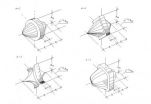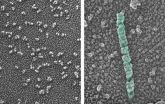(Press-News.org) SALT LAKE CITY – A team of researchers from the University of Utah and Brigham Young University has developed a mouse model of focal dermal hypoplasia, a rare human birth defect that causes serious skin abnormalities and other medical problems. This animal model not only provides insight into studying the cause of focal dermal hypoplasia (FDH), but also offers a novel way to study a signaling pathway that is crucial for embryonic development.
The findings were published July 19, 2011, online in the Proceedings of the National Academy of Sciences.
FDH is an uncommon X chromosome-linked genetic disorder characterized by distinctive skin abnormalities and a wide variety of defects affecting the eyes, teeth, fingernails, skeleton, and other body systems. The exact prevalence of FDH is not known, but about 90 percent of cases occur in females. The disorder has been associated with at least 24 different mutations in a gene called PORCN located on the X chromosome. Based on studies in cultured cells and in lower model organisms, PORCN is known to promote secretion of Wnt signaling proteins, key regulators of embryonic development.
"In addition to the integral role it plays in the development of nearly all body tissues, the Wnt signaling pathway has also been implicated in the development of diseases such as cancer and diabetes," says L. Charles Murtaugh, Ph.D., associate professor of human genetics at the University of Utah and lead author on the study. "In our research, we mutated the mouse version of the PORCN gene to better understand its exact functions in the Wnt signaling pathway."
Murtaugh and his colleagues found evidence that PORCN is required for secretion and activity of Wnt proteins, supporting the widely held hypothesis that FDH is a disease of impaired Wnt signaling. They also found PORCN is essential for formation of the mesoderm, the layer of embryonic cells that gives rise to the connective tissues of the body, as well as the linings of several body cavities and the protective layers of most of the internal organs.
Human geneticists have observed that FDH can be passed from mothers to daughters but not sons.
"Females with FDH have two X-chromosomes, one normal and one mutant. Males only have one X-chromosome, and our work suggests that if they get the mutant chromosome, they would die at very early embryonic stages due to a lack of mesoderm," Murtaugh says. "Females survive to birth, because of their normal copy of the PORCN gene, and present with the disease when born. This is true in our mice as well, as we observed that female mice with mutant PORCN displayed skin and limb abnormalities, which varied widely in severity and closely resembled human FDH."
The hallmark of human FDH is thin or absent patches of the inner layer of the skin, or dermis, which develops from mesodermal cells immediately underneath the embryonic skin, or ectoderm. When Murtaugh and his colleagues selectively deleted PORCN from the ectoderm, they found abnormal development of the underlying dermis, suggesting that ectoderm cells require PORCN to send Wnt signals that promote dermis development.
Along with defects of the dermis, human FDH is commonly associated with defects in the hair, teeth, and nails. Murtaugh and his colleagues found evidence that these and other defects also reflect the function of PORCN in the ectoderm.
"Our development of a PORCN mutant in the mouse gives us a unique genetic tool for studying the precise roles of PORCN in the Wnt signaling pathway and in specific body tissues," says Murtaugh. "In addition to giving us an animal model to study FDH, this PORCN mutant will also be useful for studying cancer and other aspects of development biology that involve Wnt signaling."
### END
Animal model sheds light on rare genetic disorder, signaling pathway
Focal dermal hypoplasia causes skin abnormalities
2011-07-22
ELSE PRESS RELEASES FROM THIS DATE:
Genetic map of African-Americans to aid study of diseases, human evolution
2011-07-22
JACKSON, Miss. – A group of researchers from the University of Oxford, Harvard Medical School and the University of Mississippi Medical Center has constructed the world's most detailed genetic map, a tool scientists can use to better understand the roots of disease and how DNA is passed generationally to create diversity in the human species.
About 5,000 Jackson-area volunteers were included in a group of nearly 30,000 African-Americans whose genetic information the scientists used to create the map.
The map pinpoints genome locations where people splice together DNA ...
URMC researchers exploring keys to melanoma progression
2011-07-22
Melanoma is devastating on many fronts: rates are rising dramatically among young people, it is deadly if not caught early, and from a biological standpoint, the disease tends to adapt to even the most modern therapies, known as VEGF inhibitors. University of Rochester researchers, however, made an important discovery about proteins that underlie and stimulate the disease, opening the door for a more targeted treatment in the future.
This month in the journal Cancer Research, Lei Xu, Ph.D., assistant professor of Biomedical Genetics at the University of Rochester Medical ...
TGen, Virginia G. Piper Cancer Center studying new breast cancer drug
2011-07-22
SCOTTSDALE, Ariz. — July 20, 2011 — A new drug targeting the PI3K gene in patients with advanced breast cancer shows promising results in an early phase I investigational study conducted at Virginia G. Piper Cancer at Scottsdale Healthcare, according to a presentation by oncologist Dr. Daniel D. Von Hoff at the 47th annual meeting of the American Society of Clinical Oncology (ASCO).
The drug under investigation, GDC-0941, manufactured by Genentech Inc., South San Francisco, Calif., targets the PI3K gene, which is abnormal in about 20-30 percent of patients with advanced ...
Fast prediction of axon behavior
2011-07-22
Researchers at Case Western Reserve University have developed a computer modeling method to accurately predict how a peripheral nerve axon responds to electrical stimuli, slashing the complex work from an inhibitory weeks-long process to just a few seconds.
The method, which enables efficient evaluation of a nerve's response to millions of electrode designs, is an integral step toward building more accurate and capable electrodes to stimulate nerves and thereby enable people with paralysis or amputated limbs better control of movement.
To increase the accuracy of the ...
U of M researchers discover gene required to maintain male sex throughout life
2011-07-22
MINNEAPOLIS / ST. PAUL (July 20, 2011) – University of Minnesota Medical School and College of Biological Sciences researchers have made a key discovery showing that male sex must be maintained throughout life.
The research team, led by Drs. David Zarkower and Vivian Bardwell of the U of M Department of Genetics, Cell Biology and Development, found that removing an important male development gene, called Dmrt1, causes male cells in mouse testis to become female cells.
The findings are published online today in Nature.
In mammals, sex chromosomes (XX in female, XY ...
Research outlines math framework that could help convert 'junk' energy into useful power
2011-07-22
BUFFALO, N.Y. -- A University at Buffalo-led research team has developed a mathematical framework that could one day form the basis of technologies that turn road vibrations, airport runway noise and other "junk" energy into useful power.
The concept all begins with a granular system comprising a chain of equal-sized particles -- spheres, for instance -- that touch one another.
In a paper in Physical Review E this June, UB theoretical physicist Surajit Sen and colleagues describe how altering the shape of grain-to-grain contact areas between the particles dramatically ...
Survey: Killing of bin Laden worsened Americans' views of US Muslims
2011-07-22
COLUMBUS, Ohio – Instead of calming fears, the death of Osama bin Laden actually led more Americans to feel threatened by Muslims living in the United States, according to a new nationwide survey.
In the weeks following the U.S. military campaign that killed bin Laden, the head of the terrorist organization Al Qaeda, American attitudes toward Muslim Americans took a significant negative shift, results showed.
Americans found Muslims living in the United States more threatening after bin Laden's death, positive perceptions of Muslims plummeted, and those surveyed were ...
Seeing the S-curve in everything
2011-07-22
DURHAM, N.C. – Esses are everywhere.
From economic trends, population growth, the spread of cancer, or the adoption of new technology, certain patterns inevitably seem to emerge. A new technology, for example, begins with slow acceptance, followed by explosive growth, only to level off before "hitting the wall."
When plotted on graph, this pattern of growth takes the shape of an "S."
While this S-curve has long been recognized by economists and scientists, a Duke University professor believes that a theory he developed explains the reason for the prevalence of this ...
After the revolution: Groups vie for minds, votes of Egyptians
2011-07-22
Los Angeles, (July 2011) — Despite helping to push Hosni Mubarak and his regime from power, Egypt's liberals and pro-democracy activists are having trouble moving from revolution to politics, according to a recent article in the World Policy Journal (published by SAGE).
In this in-depth look at the Egyptian political landscape, the article's author, Jenna Krasjeki, examines various groups vying for influence and public support in the run-up to elections this fall. One common characteristic that Krasjeski notes is the lack of organization in the groups of young, liberal ...
Evolution provides clue to blood clotting
2011-07-22
A simple cut to the skin unleashes a complex cascade of chemistry to stem the flow of blood. Now, scientists at Washington University School of Medicine in St. Louis have used evolutionary clues to reveal how a key clotting protein assembles. The finding sheds new light on common bleeding disorders.
The long tube-shaped protein with a vital role in blood clotting is called von Willebrand Factor (VWF). Made in cells that form the inner lining of blood vessels, VWF circulates in the blood seeking out sites of injury. When it finds them, its helical tube unfurls to catch ...
LAST 30 PRESS RELEASES:
Chicago health information leader recognized for raising CPR readiness and blood pressure awareness
The Intimate Animal, a new book from Kinsey Institute Executive Director Dr. Justin Garcia
When blue-collar workers lose union protection, they try self-employment
New video dataset to advance AI for health care
MEA-based graph deviation network for early autism syndrome signatures in human forebrain organoids
New modeling approach sheds light on rare gut disease
Study documents potentially hazardous flame retardants in firefighter gear
Can certain bacteria regulate aging of the immune system and its related alterations?
AI model helps diagnose often undetected heart disease from simple EKG
There are fewer online trolls than people think
Cell membrane fluctuations produce electricity
Jeonbuk National University study shows positive parenting can protect adolescents against self-harm
Surface-engineered ZnO nanocrystals to tackle perfluoroalkyl substance contamination
This new understanding of T cell receptors may improve cancer immunotherapies
A new fossil face sheds light on early migrations of ancient human ancestor
A new immunotherapy approach could work for many types of cancer
A new way to diagnose deadly lung infections and save lives
40 percent of MRI signals do not correspond to actual brain activity
How brain-inspired algorithms could drive down AI energy costs
Gum disease may be linked to plaque buildup in arteries, higher risk of major CVD events
Contrails are a major driver of aviation’s climate impact
Structure of dopamine-releasing neurons relates to the type of circuits they form for smell-processing
Reducing social isolation protects the brain in later life
Keeping the heart healthy increases longevity even after cancer
Young adults commonly mix cannabis with nicotine and tobacco
Comprehensive review illuminates tau protein's dual nature in brain health, disease, and emerging psychiatric connections
Book prepares K-12 leaders for the next public health crisis
Storms in the Southern Ocean mitigates global warming
Seals on the move: Research reveals key data for offshore development and international ecology
Sports injuries sustained during your period might be more severe
[Press-News.org] Animal model sheds light on rare genetic disorder, signaling pathwayFocal dermal hypoplasia causes skin abnormalities


